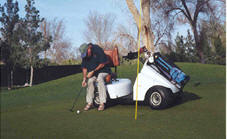Accessible Golf Courses - A Summary of Accessibility Guidelines for Recreation Facilities
Introduction
The Americans with Disabilities Act (ADA) is a comprehensive civil rights law that prohibits discrimination on the basis of disability. The ADA requires that newly constructed and altered state and local government facilities, places of public accommodation, and commercial facilities be readily accessible to, and usable by, individuals with disabilities. The ADA Accessibility Guidelines (ADAAG) is the standard applied to buildings and facilities. Recreational facilities, including golf courses, are among the facilities required to comply with the ADA.

The Access Board issued accessibility guidelines for newly constructed and altered recreation facilities in 2002. The recreation facility guidelines are a supplement to ADAAG. As a supplement, they must be used in conjunction with ADAAG. References to ADAAG are mentioned throughout this summary. Once these guidelines are adopted by the Department of Justice (DOJ), all newly designed, constructed and altered recreation facilities covered by the ADA will be required to comply.
The recreation facility guidelines cover the following facilities and elements:
-
Amusement rides
-
Boating facilities
-
Fishing piers and platforms
-
Miniature golf courses
-
Golf courses
-
Exercise equipment
-
Bowling lanes
-
Shooting facilities
-
Swimming pools, wading pools, and spas
This guide is intended to help designers and operators in using the accessibility guidelines for golf courses. These guidelines establish minimum accessibility requirements for newly designed or newly constructed and altered golf courses. This guide is not a collection of golf course designs. Rather, it provides specifications for elements within a golf course to create a general level of usability for individuals with disabilities. Emphasis is placed on ensuring that individuals with disabilities are generally able to access the golf course and use a variety of elements. Designers and operators are encouraged to exceed the guidelines where possible to provide increased accessibility and opportunities. Incorporating accessibility into the design of a golf course should begin early in the planning process with careful consideration to the layout of the course, golf car paths, and other circulation paths.
The recreation facility guidelines were developed with significant public participation. In 1993, the Access Board established an advisory committee of 27 members to recommend accessibility guidelines for recreation facilities. The Recreation Access Advisory Committee represented the following groups and associations:
-
American Ski Federation
-
American Society for Testing and Materials (Public Playground Safety Committee)
-
American Society of Landscape Architects
-
Beneficial Designs
-
City and County of San Francisco,California, Department of Public Works
-
Disabled American Veterans
-
Environmental Access
-
Golf Course Superintendents Association of America
-
Hawaii Disability and Communication Access Board
-
International Association of Amusement Parks and Attractions
-
Katherine McGuinness and Associates
-
Lehman, Smith, and Wiseman Associates
-
Michigan Department of Natural Resources
-
National Council on Independent Living
-
National Park Service
-
National Recreation and Park Association
-
New Jersey Department of Community Affairs
-
Outdoor Amusement Business Association
-
Paralyzed Veterans of America
-
Professional Golfer’s Association
-
Self Help for Hard of Hearing People
-
States Organization for Boating Access
-
Universal Studios
-
U.S. Army Corps of Engineers
-
U.S. Forest Service
-
Y.M.C.A. of the U.S.A.
-
Walt Disney Imagineering
The public was given an opportunity to comment on the recommended accessibility guidelines, and the Access Board made changes to the recommended guidelines based on the public comments. A notice of proposed rulemaking (NPRM) was published in the Federal Register in July 1999, followed by a five-month public comment period. Further input from the public was sought in July 2000 when the Access Board published a draft final rule soliciting comment. A final rule was published in September 2002.

User Comments/Questions
Add Comment/Question